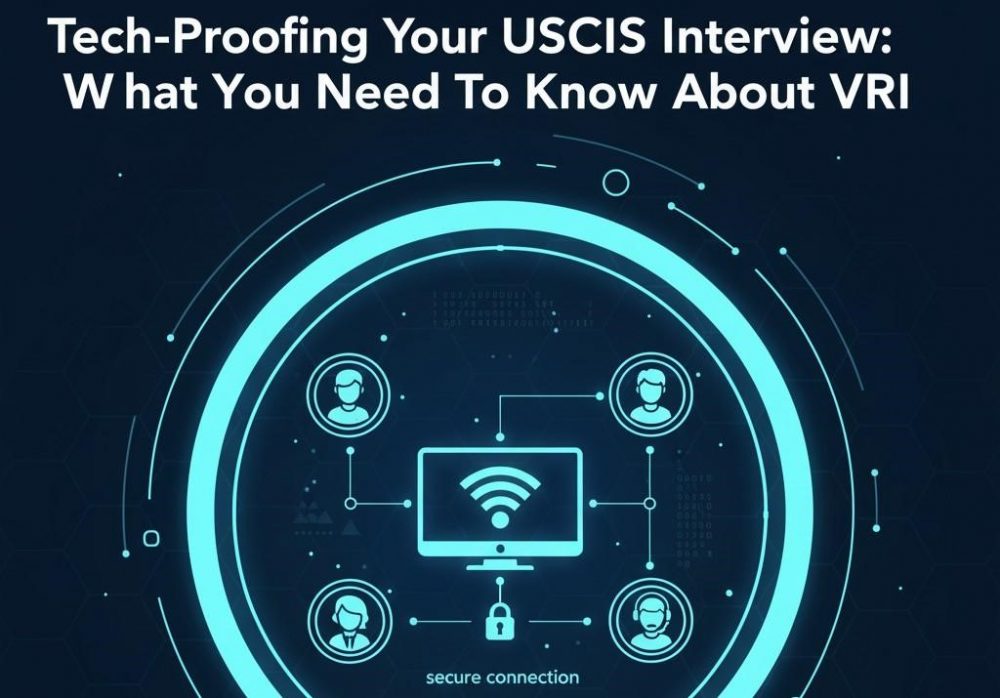1. What is VRI, and why is it so important?
VRI stands for Video Remote Interpreting. It is a technology platform that provides language translation through video calling. To put it simply, it is something like Skype or Zoom, but with professional human interpreters. The service becomes essential when a person does not have immediate access to an interpreter in their required language.
The use of VRI technology in immigration interviews has increased rapidly since the COVID-19 pandemic. It makes the interview process more flexible and faster at USCIS. The applicant and the interpreter may be in different locations, saving time and travel for both. This approach furthers language access and provides quicker services.
2. VRI’s Growing Trends in USCIS Interviews
United States Citizenship and Immigration Services, USCIS for short, has started embracing VRI, especially for citizenship, asylum, and other vital interviews. Its primary aim is to guarantee that equal and accurate USCIS interpreting services are given to every applicant regardless of their language.
With VRI, USCIS is able to access specialized interpreters that might otherwise not be available at a physical office. This helps reduce applicant delays in obtaining an interview date. Keep in mind, the success of the VRI rests completely on technology and interpreter training, both of which may vary from interview to interview with USCIS.
3. Technical Aspects and Requirements of VRI
The VRI system requires some basic technical requirements. Most importantly, it needs a high-speed and stable internet connection. Poor internet connection speed and strength will result in disruptions of video and audio, thereby degrading translation quality.
Added to that is a good microphone and camera. In the USCIS interview, the officer must see and hear the applicant and the interpreter clearly. It would avoid any misunderstandings in communication. Always check your equipment before using VRI.
4. The Issue of Accuracy and Confidentiality
Does VRI provide accurate translation? VRI is as accurate as an in-person interpretation if the technology is functioning appropriately. Professional interpreters adhere to their ethics and training.
Confidentiality is one important element of VRI. Matters under discussion at the USCIS are very confidential. VRI platforms must ensure end-to-end encryption and a secure connection so that no leak of data occurs. Applicants should show confidence that their interview information with the USCIS will remain confidential.
5. Applicant Preparation (Tech-Proofing Yourself)
If the USCIS interview with you is via VRI, you need to tech-proof yourself. First, choose a location that is quiet and well-lit. The clearer the lighting and the lower the noise, the better the interpreter will be in understanding your tone and body language.
Another important thing you must do is check your technology. Do an audio and video test with your computer or device before the interview. Make sure the microphone and speaker work well. If you are not prepared, your USCIS interview performance may be affected.
6. Body Language and Video Interpreting
In VRI, it is not just about your voice that human interpreters listen to but also body language and face expressions, which often help them get hold of the real meaning of what is being uttered. Therefore, you must be facing the camera and speak like you are talking with a person facing you.
Sit up straight and look into the camera when speaking during the interview. Avoid excessive hand or facial motion, which distorts your video. Remember that VRI is a digital window where every movement and speech matters in affecting the results of your USCIS interview.
7. The Future of VRI and Avenues for Improvement
VRI is still at its developing phase, and in the future, more changes are expected with the addition of 5G and AI. AI tools, for instance, can make the VRI platforms faster by reducing background noise and detecting facial expressions.
But in spite of this, the role of human interpreters will always be paramount. It is for this reason that VRI has been implemented: it does not replace human expertise but instead complements such expertise. In this way, it will help them enhance their chances of success at the USCIS interview. Things that were difficult due to geography or specialized language will become easy.
8. Interpreters’ Training Plays a Key to VRI Success
Much of the success with VRI depends on the interpreters’ training. Interpreters need training not only in translation but also in the use of the VRI equipment, software, and video etiquette.
They need to know how to manage the communication when video is involved. Tech-savvy interpreters can then utilize VRI better, which would make a smooth and effective interview at the USCIS. Therefore, the agencies providing VRI services should pay more attention to the technical training of their human interpreters.
FAQs
1. Will VRI make my USCIS interview easier?
VRI will make your USCIS interview more accessible and quicker, especially if there isn’t a spoken word interpreter available at the office. However, success depends on internet connection and your technical preparation.
2. What equipment will I need for VRI?
You will need a good quality computer, tablet, or smartphone, a stable and high-speed internet connection, and a good microphone and speakers for clear voice.
3. Is VRI translation as accurate as in-person translation?
Yes, if the internet and audio/video quality are good, then VRI translation can be as accurate as in-person translation. Accuracy depends on the training and professionalism of the human interpreters.
